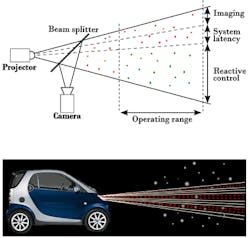Smart headlight could improve visibility for drivers
Standard vehicle headlights improve the vision of drivers at night by illuminating the road and the surrounding environment. Unfortunately, they also illuminate raindrops and snowflakes making them appear as bright flickering streaks that are very distracting.
Now, however, researchers at Carnegie Mellon's School of Computer Science (Pittsburgh, PA, USA) have developed a novel system that is capable of eliminating the effects of such precipitation by identifying where the raindrops are located and reactively deactivating the rays of light from a headlight to avoid illuminating them.
The Carnegie Mellon system consists of a projector, a camera and a beam splitter. At the top of the camera's field of view, particles such as raindrops, snowflakes, and hailstones are illuminated by the projector and the images of them are captured by a camera. This region of the image is then used by a computer algorithm to predict the trajectory of particles across following frames.
Once the known trajectory of the particles has been determined, the direction of light from the projector can be controlled to prevent it from illuminating the locations where the particles are predicted to fall. Simultaneously, any particles that are erroneously illuminated by the system are also detected by the camera and used by the system to update its predictions.
To date, the researchers have conducted simulations and built a prototype system to show that their approach is feasible and effective.
More details of the work and associated videos of the system can be found here.
Many researchers are using computer vision systems in automotive applications. Here's a compendium of five of the top stories on the subject that Vision Systems Design has published over the past year.
1.Vision system helps curb drunken drivers
Drunk driving may soon become a thing of the past thanks to a face-recognition program developed by a pair of University of Windsor (Windsor, Ontario, Canada) engineering graduate students.
2.Algorithm helps eliminate blind spot in mirrors
A Drexel University (Philadelphia, PA, USA) mathematics professor has developed a computer program that can create a curved mirrored surface that provides an undistorted wide angle field of view.
3.Research car helps team study habits of older drivers
A unique research car has been fitted out with eye tracking systems and bio-monitors by engineers at Newcastle University (Newcastle, UK) to monitor the concentration, stress levels and driving habits of drivers.
4.Vision system monitors the transport of dangerous goods
Engineers at Survision (Rueil-Malmaison, France) have developed a vision system to detect the signs on the vehicles that indicate what substances they are carrying and their number plates.
5.App turns camera phone into crash warning system
A new app uses the camera in an Android smart phone to measure the relative speed and distance between a vehicle and those in front it, broadcasting audio and visual collision warnings whenever the risk of an impending collision is detected.
-- Dave Wilson,Vision Systems Design
